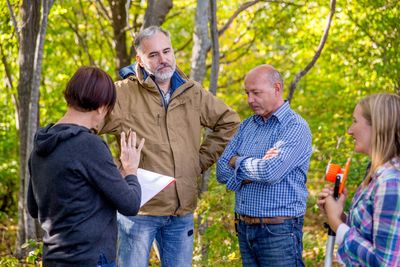Communication During a Disaster
The Importance of Communication in a Disaster
In the event of a disaster, basic services like power, cell phone service, and internet can be disrupted. In most cases these services are restored within a few days, however, disruptions can last weeks if roads are impassable or power is out. During and after a disaster, communication is important for receiving official updates and alerts, checking on relatives and friends, and getting help to those who need it. Communication is also vital to coordinate response and recovery efforts.

How to Obtain Official Disaster Information
Before, during, and after a disaster it is important to stay informed about the situation. Knowledge about the situation from official sources can reduce panic and prevent the spread of misinformation. Official sources will also provide information that can help you take actions before an event to protect life and property, stay safe during and after a disaster, and connect with local resources.
Official emergency communications in Pueblo County include:
- Emergency alerts - sign up to receive emergency alerts
- Pueblo County Emergency Status Board - this is a website that displays information about current disasters in Pueblo County
- TV alerts - the Pueblo County Sheriff’s office provides updates to the following channels: KKTV11 (CBS), KOAA 5/30 (NBC), KRDO13 (ABC), and KXRM 21 (FOX).
- Radio alerts - KCCY 96.9 FM is a local radio station that broadcasts local emergency information. In addition, emergency weather alert radios can be purchased that are battery powered, powered by a hand crank, solar powered, or a combination. Having a battery powered radio is recommended because the sun is not always out and the hand crank method of power is time consuming. Be sure to store extra batteries. Solar powered and hand crank radios can be a good option for an extended power outage when batteries run out. Click here to learn more about the NOAA weather radio system.

Communication Plans
Each family should have a plan for emergency home evacuation. This should include identifying safe evacuation routes and agreeing to a meet-up location near the home. You should also agree on a location to meet up in another city should officials announce an emergency evacuation in your area.
- Click here for a printable template. - Habitat for Humanity
- Ready.gov has an electronic form where you can enter your information and create a PDF emergency plan to email to other family members. Click here to use the electronic form.
- Be sure to include a photograph of each family member.
During and after an event friends and relatives will want to know if you are OK. There may be times when you can send a short text but an actual phone call is not a possibility.
- Create an emergency contact list.
- Designate a point person in the family that can receive messages from family members within a disaster-affected area and relay the information to other family members. The point person should not live in your area. Long distance calling or text messaging may be available when local calls aren’t working.
- Have a neighborhood communication plan. Get to know your neighbors so that you can check on neighbors that are elderly or have small children, or have medical conditions first.
- Review the Pueblo Colorado Stake emergency communications plan - see page 5.

How to Communicate when Cell Service and Internet are Down
Every day there are people who experience an emergency, such as heart attack, stroke or housefire. The best way to get immediate help is to dial 911. These types of emergencies still occur during a disaster event, however, cell phones service may be unavailable. Being able to communicate emergency needs can save someone’s home or life.
Alternative methods to communicate when cell phones are down include:
- GMRS radio - easy to use, short range, requires a license
- Amateur (HAM) radio - the most reliable means of communication
- Satellite phones - this is a good option but can be expensive to use
Ideally, Pueblo would have many individuals that can use HAM radios. Leaders of local organizations should know which individuals in their organization are HAM radio operators.

Additional Resources
Click on the links below to learn more.
- Emergency Communication Guidelines - The Church of Jesus Christ of Latter-day Saints
- Pueblo County Emergency Operations Plan - the communications plan is on pages 61-65

Copyright © 2025 Prepared in Faith - All Rights Reserved.
This is not an official website of The Church of Jesus Christ of Latter-day Saints
This website uses cookies.
We use cookies to analyze website traffic and optimize your website experience. By accepting our use of cookies, your data will be aggregated with all other user data.